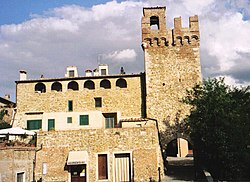|
Istia d'Ombrone
Istia d'Ombrone (Italian: [ˈistja domˈbroːne]) is a small town in southern Tuscany, Italy, a frazione of the comune of Grosseto. HistoryIn the area surrounding the centre of Istia there have been found some ruins of ancient habitations dating back to the Etruscan era in the area of Poggio Cavallo. It was inhabited also during the Roman era, as testified by some construction materials reused in later periods to build the walls of Istia. In that period there was also a series of roads which crossed the area allowing communication with the Lake Prile and with the hinterland. However the centre of Istia arose as a settlement fortified along the Valley of Ombrone and from 862 was owned by the bishops of Roselle, which had feudal rights with the title of counts and so here they established a residence. Later it passed to the family of the Aldobrandeschi, becoming in 1226 a free Comune with the acceptance of the relative statute. In 1274 it was assigned to the County of Santa Fiora at the moment of the division of the goods and the territories controlled by the Aldobrandeschi family. In the Medieval period the centre became also home to a residence of bishops, after the passage of the diocese from Roselle to Grosseto. In the course of the 14th century it passed under the control of Siena, enduring a very serious demographic decline between 1331 and 1353, also because of the diffusion of the Yersinia pestis which occurred right at the end of that period. In the 15th century Istia had become a feud of the Piccolomini family, even though it continued to maintain the status of free Comune and having a high degree of autonomy within the Republic of Siena. After the final political fall of Siena, Istia become part of the Grand Duchy of Tuscany. Consequently, there was another demographic fall which stopped only during the course of the 18th century, after the beginning of some restorations done by will of the Lorena. During the Second World War, on 22 March 1944, the Maiano Lavacchio massacre took place into the nearby countryside. Main sightsThe town walls, nearly completely destroyed in 1137 by Henry X, Duke of Bavaria, were rebuilt only under the Sieneses. Some ruins of the Portaccia and the Porta Grossetana, which backs to the Palzzo della Giustizia dating to the 1400, are conserved. The residence of the bishop-counts, the Palazzo di San Salvatore, was afterwards transformed into a fortification by the Sieneses. In the town there are also two churches, one within the walls and the other on the outside of the walls in front of the Porta Grossetana. Military architecture
 Palazzi
Churches
Missing architecture
Bibliography
See alsoExternal links
|
||||||||||||||||||||||||||||||||||

